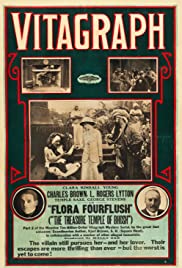F …is for
The Fates and Flora Fourflush
The Fates and Flora Fourflush; or, The Ten Billion Dollar Vitagraph Mystery Serial, the first serial produced by the Vitagraph Company, was released on October 26, 1914. Written by Mark Swan and James Young, it was unusual in several ways. The first way was its length: it ran a mere three episodes, or chapters. The second was its form: a comic parody, it spoofed the detective and mystery stories that were so popular with moviegoers at the time.
The Thanhouser Company’s The Million Dollar Mystery, a twenty-three part serial released the previous year, had told the story of a clandestine Russian society, “The Black Hundred.” After Florence Hargreave’s father terminates his connection to that organization, Countess Olga Petroff (Marguerite Snow) and the other members of the group vow revenge and determine to secure his million-dollar fortune for themselves. After the elder Hargreave outwits the group and escapes in a balloon, the gangsters come after Florence (played by Florence “Fearless Flo” La Badie) to compel her to reveal the money’s secret hiding place. Despite numerous close encounters—on an airship, in the path of an oncoming train, in a seaplane, in quicksand—she eventually frustrates their evil and greedy plan.
The Fates and Flora Fourflush was an obvious parody of this trend and especially of Thanhouser’s serials. Clara Kimball Young played Flora, the female lead; Charles Brown was her devoted suitor Frank Goodheart, while L. Rogers Lytton appeared as their arch-nemesis Simon Blackheart. As film critic Kalton Lahue observed, “the satire produced a thrill every minute and a laugh every thrill.”
The production combined virtually every imaginable serial plot device. In the first episode, after her enormous four-horse-power “Combustible” runs over poor but honest street-cleaner Frank, the orphaned heiress Flora takes him to her home to recover from his injuries. There, Frank clashes with Sir Simon, a suitor whose marriage proposal Flora has rejected. Although Frank and Flora share an obvious affection, he refuses to wed until he has made his own fortune (a twist on The Perils of Pauline plot, in which Pauline refuses to marry Harry Marvin until she has had a chance to have her own year of adventure). After Simon tampers with the plane Flora is planning to fly across the Atlantic, Frank jumps into a hot air balloon and rescues her in a daring mid-air rescue. But a furious Simon shoots his rifle into the balloon and downs it, sending Flora and Frank to seemingly certain death.
Clearly not meant to be a serious or dramatic production, The Fates and Flora Fourflush provided an entertaining send-up of the popular serial genre of its day. Vitagraph went on to produce numerous other serials, including The Goddess (1915), The Scarlet Runner (1916), The Fighting Trail (1917), and The Woman in the Web (1918).
Survival Status: presumed lost
Directors: Wally Van
Release Date: October 26, 1914
Release Company: Vitagraph Company
Cast: Clara Kimball Young (Flora Fourflush), Charles Brown (Frank Goodheart), L. Rogers Lytton (Sir Simon Blackheart), Templar Saxe (The Rajah), George Stevens (High Priest).
Episodes: (all one reel) 1. Treachery in the Clouds. 2. The Treasure Temple of Bhosh. 3. A Race For Life.


